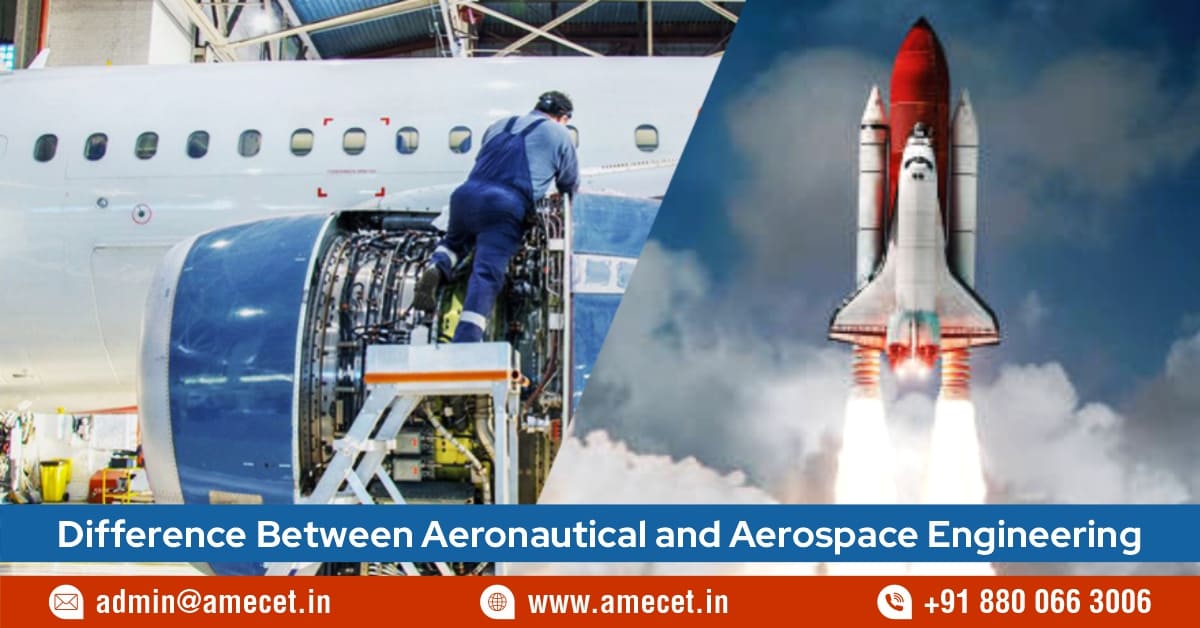Difference Between Aeronautical and Aerospace Engineering
Posted on : 23 August, 2025 3:32 pm
Aeronautical and aerospace engineering are two fields that are quite similar and that students often confuse with one another. Both fields concern themselves with the science and technology of flight; however, they differ in scope, application, and career prospects. Knowing the difference between these two branches is very important to anyone aspiring to enter in aviation or space industry careers.
Aeronautical engineering deals with aircraft capable of flying within the Earth’s atmosphere. These include commercial airplanes, helicopters, fighter jets, and drones, to name a few. The emphasis of this field is on the correct use of aerodynamics, propulsion, avionics, materials, and structural analysis to ensure air travel is safe and convenient. Some of the typical employers who might hire aeronautical engineers are airlines, defense establishments, research institutes, and companies for manufacturing aircraft. They seek to improve features of an aircraft, diminishing fuel consumption, enhancing safety, and meeting regulatory compliance.
Aerospace engineering, on the other hand, is a broader discipline that includes both aeronautical engineering and astronautical engineering. It deals with vehicles operating inside and outside the Earth’s atmosphere. In addition to aircraft, aerospace engineers work on spacecraft, satellites, space shuttles, rockets, and even interplanetary vehicles. This branch combines advanced knowledge of physics, propulsion systems, thermodynamics, and materials science to develop machines capable of surviving extreme conditions in outer space. Professionals in this field often collaborate with organizations like NASA, ISRO, or private companies such as SpaceX, which are engaged in space exploration and satellite technology.
The career opportunities also differ
. Aeronautical engineers often find employment in civil aviation, defense aviation, aircraft manufacturing, and air safety organizations. Aerospace engineers, meanwhile, can explore careers not only in aviation but also in space research, satellite communications, and planetary missions. Both fields, however, demand strong technical knowledge, problem-solving abilities, and creativity.
Difference Between Aeronautical and Aerospace Engineering
| Aspect | Aeronautical Engineering | Aerospace Engineering |
| Definition | A branch of engineering focused on the design, development, and maintenance of aircraft operating within Earth’s atmosphere. | A broader field that covers both aeronautical (aircraft) and astronautical (spacecraft) engineering. |
| Scope | Limited to airplanes, helicopters, drones, and other atmospheric flight vehicles. | Includes aircraft, spacecraft, satellites, rockets, and planetary vehicles. |
| Key Subjects | Aerodynamics, propulsion, avionics, materials, aircraft structures, and flight mechanics. | Combines aeronautical subjects with astronautics, orbital mechanics, thermodynamics, and space systems. |
| Work Environment | Civil aviation, defense aviation, aircraft manufacturing, airline maintenance, and safety organizations. | Space research centers, aerospace companies, satellite communication industries, and rocket development. |
| Examples of Work | Designing commercial airplanes, fighter jets, or UAVs for transport and defense. | Developing rockets, satellites, reusable spacecraft, and interplanetary exploration vehicles. |
| Organizations | HAL, DRDO, commercial airlines, and aircraft companies like Boeing or Airbus. | NASA, ISRO, SpaceX, and with aerospace giants like Lockheed Martin. |
| Career Opportunities | More focused on aviation industry roles. | Broader prospects in both aviation and space technology. |

